Suspended, collapsed, stacked, wrapped or folded, the works of Phyllida Barlow spring from an interrogation of some of the most fundamental aspects of sculpture: its physical attributes and its presence in space. Described by Barlow as ‘a strange medium that takes up space’, sculpture, she has explained, ‘brings things into the world’, adding, ‘there is already too much stuff in the world. So it’s kind of absurd, and its absurdity is what I find fascinating.’1 Her ambivalence about the purpose of sculpture is reflected in the formal tensions that characterise her work and are visible in the processes of making that permeate its surfaces, its exaggeration and awkwardness, and the contradictions that stem from combining softness and hardness, the painterly and the sculptural.
Barlow was born in Newcastle upon Tyne in 1944 but grew up in London, where she lives and works. She studied sculpture at the Chelsea School of Arts (1960–3) and later at the Slade School of Art (1963–6), where she received a traditional education in sculpture, learning conventional techniques such as clay and plaster modeling, metal casting, armature construction and assemblage with metal and wood. According to the artist, all this ‘constituted a somewhat grim ritual by which the student was initiated into the highly specialised and selective, even elitist, world of sculpture’,2 but she recalled her student years as a ‘thrilling time, with Arte Povera and Pop Art bursting through’.3 The 1965 exhibition New Generation at the Whitechapel Gallery, London, introduced her to new possibilities in sculpture in Britain. However, her attention soon shifted towards Europe and America, in particular towards the innovative work of post-minimalist artists who used unconventional materials and open structures.
With remarkable continuity of purpose Barlow has focused from the late 1960s to today on the physical experience of handling materials, which she transforms through processes of layering, accumulation and juxtaposition. Obtrusive and invasive, Barlow’s large-scale sculptural objects are frequently arranged in complex installations in which mass and volume seem to be at odds with the space around them. Their role is restless and unpredictable: they block, interrupt, intervene, straddle and perch, both dictating and challenging the experience of viewing.
Colossal in scale, the seven interrelated yet autonomous pieces that comprise Barlow’s dock 2014 are closely linked to the architectural context of the Duveen Galleries at Tate Britain, the first public galleries in England designed specifically for the display of sculpture. Physically intrusive, the works impede the way, almost overfilling the 100-metre-long barrel-vaulted galleries and projecting a dual, even contradictory identity: monumental on the one hand, collapsed on the other. Made of lightweight materials such as timber, metal, polystyrene, tarpaulin, canvas, cardboard and rope, with some pieces looking battered or ravaged, dock offers an antagonistic counterpart to the austere neoclassical vessel housing it, abounding in formal irony to represent everything the Duveen Galleries are not – excess, chaos, disproportion, dissonance, malleability and ephemerality. Barlow’s interest in large, expansive sculptural installations responds to her desire to ‘argue with space’. She also wants her work to question ‘inherited masculine authority’ as reflected in the buildings in which her work is sited.4 Consequently, dock aims to establish its own autonomous presence against the values and forms of the gallery that houses it.
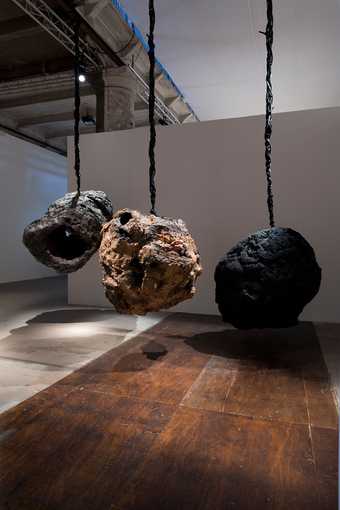
Fig. 1
Installation view of the 55th International Art Exhibition: The Encyclopedic Palace, Venice Biennale 2013
Courtesy of the artist and Hauser & Wirth
Positioned along the central axis of the Duveen Galleries, a series of self-supporting timber frame structures stand stripped of artifice, like the skeletons of a dystopian landscape. Made with a simple construction method that has been used for centuries, these rudimentary and seemingly unstable arcades contrast with the permanence and grandeur of the architecture around them. Blocks, barrels and abstract forms are suspended at different heights in what the artist has referred to as ‘a state of uncertainty, a limbo’5 . Barlow has only recently started working with suspended sculptural objects: in The Encyclopedic Palace at the Venice Biennale of 2013 she hung large ‘lumps’ from the ceiling at different heights. Such suspended works defy gravity and reveal the normally hidden underside of the objects to viewers who move underneath and through them, making the experience of looking an active one (fig.1).

Fig. 2
Phyllida Barlow
untitled: dock: 5hungblocks 2013
Photo: Tate
In dock the hung pieces have many resonances and allude to both the gallery’s location and sculpture’s recent history. The five rectangular forms that make up untitled: dock: 5hungblocks 2013 (fig.2), for example, were inspired by the sight of a shipping container on the River Thames outside Tate Britain. Barlow explained in an interview published in early 2014:
having been in that dark space of the Duveens and then going out into the winter light and just seeing this black, shiny, coiling surface of water with the quasi-industrial riverside stuff on the other side and the floating objects, the boats and barges with big containers on them – I just thought, ‘That’s what I want to do!’. It is as though the Duveens is a portal to that view, watching this procession of sculptural objects passing in front. There was one particular barge loaded with containers and I just thought, ‘That’s fantastic.’ It had this weightless sense of something being suspended, being held in the water an air around it. It was also a wonderful minimalist reference in the sense that the cube is a plinth, a container, a vitrine – it’s all these props for sculptural language.6
As seen in the Duveens, the forms of untitled: dock: 5hungblocks dramatically obstruct the view and the thoroughfare. Suspended in a state of decay, ripped apart, wrecked and stripped of the theatrical paint and camouflage that are hallmarks of Barlow’s sculpture, they appear to be the remnants of some inexplicable catastrophe and the ruins of the squares and rectangles found in minimalist sculpture.
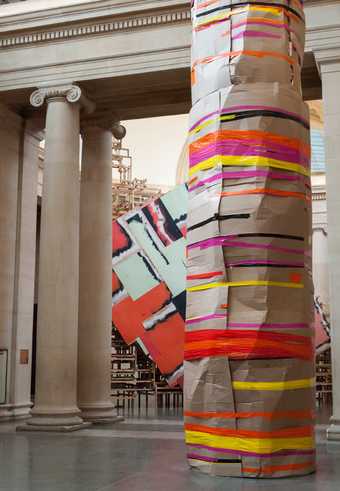
Fig. 3
Phyllida Barlow
untitled: dock: crushedtower 2014
Photo: Tate
Allusions to different traditions of sculpture appear throughout the installation. The next work encountered by the visitor making his or her way from the river entrance through the Duveen Galleries, untitled: dock: crushedtower 2014, is a twelve-metre-tall timber cylinder, clad in pieces of cardboard and wrapped around with different colour tape to hold it together (fig.3). Barlow revisits here expedient ways of working she experimented with twenty years ago in numerous stand alone objects, such as object for an armchair 1994 and object for the sitting room 1994 (some of these were later reconfigured as part of the installation Far Away 1999; fig.4). Described by Barlow as ‘an absurd endless column’,7 untitled: dock: crushedtower stands next to the pillars of the Octagon Gallery and is a functionless mock-up of a column, whose precarious appearance and phallic shape serve as a visual pun on grand sculptural statements of the past. Using ‘lightweight, disposable things’, the artist has observed elsewhere, ‘pastiches the monument or the monumental’. ‘The latter has this heroic, macho thing that I’m attracted to, but which conversely I couldn’t possibly do myself. So there’s this idea of playing the monumental game but with these crap materials, and because they are crap materials, you can mess around with them, tilting them or balancing them: forcing them to do non-monumental things. It’s both comic and grimly authoritarian’.8

Fig. 4
Installation view of Phyllida Barlow’s Across, Around, Up, Diorama Gallery, Regent’s Park, London 1992
Courtesy of the artist and Hauser & Wirth
Photo: Phyllida Barlow
This ‘authoritarian’ quality is perhaps apparent in the element of violence found in Barlow’s working methods. In her large scale works household materials, such as carpets, sheets and ropes, are often combined with miscellaneous materials, including cardboard, foam, Formica, polystyrene, concrete and timber, and are held together through various different actions, such as cutting, slicing, sawing, breaking, coiling, folding, wrapping and covering. Rather than employing traditional working methods, such as carving or welding, her work is characterised by accumulation and arrangement. Through an unmediated physical encounter with the materials, the artist manipulates structures and builds up surfaces, in ways that echo her formal training in modelling. Barlow was first introduced to clay by her tutor George Fullard at the Chelsea School of Art. There she was ‘completely taken up by the physicality of a material that didn’t immediately dictate an image, I was drawn into the material and maybe an image would emerge, but it wasn’t the immediate relationship.’9 Removed from this early way of working though her later sculpture may appear, her approach remains rooted in the traditional sculpture processes of modelling and casting, and it is something that she imparts to the assistants who physically help make her works.10

Fig. 5
Installation views of Phyllida Barlow’s Depot 1995, Museum of Installation, London 1995
Courtesy of the artist and Hauser & Wirth
Photo: Phyllida Barlow
Barlow’s ‘authoritarian’ approach can also be said to extend to her use of space: her large scale installations not only provide a setting for human action but also direct the movements of viewers around her sculptures, which she has described as ‘obstacles, nuisances’. In the early 1990s Barlow began to work with arrangements of sculptures as in Across, Around and Up 1992, later reconfigured in Depot 1995 (fig.5) and Truce 1997 (fig.6), perhaps the most representative works of this period. Consisting of large interrelated pieces whose dimensions were determined by the height, width and length of the space in which they were shown, Depot and Truce focused on ‘the space between the objects and what that did to an audience, how the audience moved around the works and discovered each one of them’.11 The gallery became a platform or stage for the works, and the viewer became an actor or performer. ‘Initially the audience is myself’, Barlow has noted. ‘How I’m physically negotiating the space is often more important than the object itself. They are obstacles to be navigated, protagonists that I feel I’m encountering. The private view consequently comes as a terrible shock, because here are all these people who are there to use the space. It feels extraordinary that the audience are being allowed on the stage and are somehow grabbing the script from me!’12
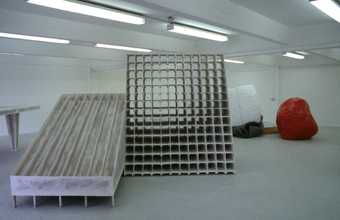
Fig. 6
Installation view of Phyllida Barlow’s Truce 1997 at East International, The Sculpture Studio, Norwich School of Art and Design 1997
Courtesy of the artist and Hauser & Wirth
Photo: Phyllida Barlow
Filling the Duveen Galleries, a space of transit that connects the south and north ends of the museum as well as the west and east sides, dock challenges the viewer to negotiate a way through the spaces. In the Octagon – the central space linking the north and south Duveen Galleries – untitled: dock: emptystaircasehoarding 2014 acts as a barrier (fig.7). Rising up to the gallery’s cornice, the imposing nine-metre-tall work is made of a vast amount of timber frames and crates of various sizes, assembled in a construction that resembles a staircase. This shape is one Barlow has used many times over her career, but the scale of the Octagon piece sets it apart from anything that she has done before. It resembles a platform but, devoid of any practical function, is clearly an object of display, a point emphasised by the fact that this is the only element in the installation that incorporates painted surfaces. The work’s modular logic conflicts with the more gestural skin of the painted crates that cover it, shifting attention once more to the working process as not just a means of construction but as a modelling of form on a particular structure. Initially conceived as a viewing stand that would afford the audience an overview of Barlow’s disjointed sculptural landscape, untitled: dock: emptystaircasehoarding dramatically divides the Octagon, blocking the long view across the north and south galleries and frustrating a sense of distance and space.
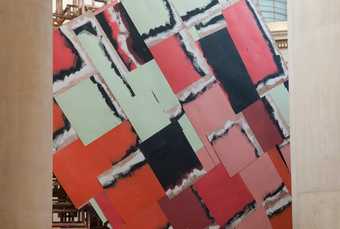
Fig. 7
Phyllida Barlow
untitled: dock: emptystaircasehoarding 2014
Photo: Tate
An installation of the scale of dock cannot be apprehended at a glance. In the north Duveen – the gallery furthest away from the river entrance – there is a great variety of works, an unfolding choreography of viewing in which the audience is encouraged to look up, down, across and around. Careful arrangements of pieces, including those hanging from the lintel structures, share the space with others that appear to have been violently or randomly discarded. untitled: dock: crashedlintel/brokensculpture/paintedtarps 2014, a seemingly collapsed structure that appears to be a pile of mere stuff, takes centre stage (fig.8). Opposite it, as if hidden in one of the gallery’s alcoves, stands untitled: dock: 5stockadecrates 2014, a series of steel frames of various heights, clad in timber with piles of debris taken from the artist’s London studio, including rope, polystyrene, cardboard, plastic and tape stuffed on top of it (fig.9).
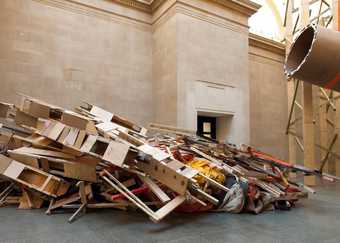
Fig. 8
Phyllida Barlow
untitled: dock: crashedlintel/brokensculpture/paintedtarps 2014
Photo: Tate
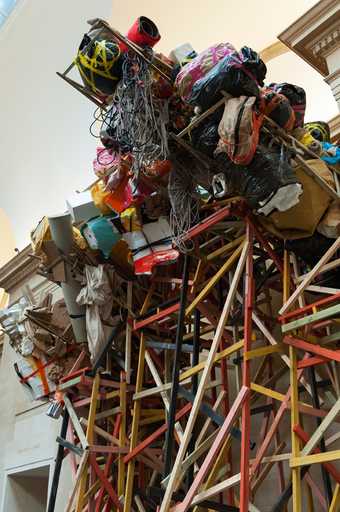
Fig. 9
Phyllida Barlow
untitled: dock: 5stockadecrates 2014
Photo: Tate
There is no single viewing position for any of these works: they prompt the viewer to keep on moving around, under and across them. The insistence on directing the viewer’s gaze across the space is an important factor in Barlow’s work, one that she first explored fully in Peninsula, an installation commissioned by the BALTIC Centre for Contemporary Art, Gateshead, in 2004 (fig.10). According to the artist, ‘it was an epiphany to make the work for the fourth floor gallery space, because it has two viewing points: one from the fifth floor where the space is seen from above, looked down on, and the other where it is entered, like going on a stage … it was this looking down, looking across, looking through that was, in a way, the subject of the work.’13 Experiencing Barlow’s sculptural installations requires moving as well as looking. ‘Things aren’t just visual’, she has said. ‘They are sensations of physicality.’14 Accordingly, the work cannot be reduced to a fixed structure or overarching form, and the shifting and incongruous juxtapositions of the shapes and materials, parts and aspects, that comprise it can be seized primarily in the sensations elicited by the body’s proximity to it.
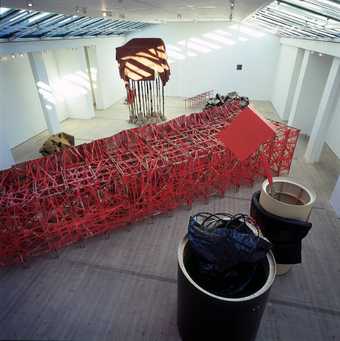
Fig. 10
Installation view of Phyllida Barlow’s Peninsula, Baltic Centre for Contemporary Art, Gateshead 2004
Courtesy of the artist and Hauser & Wirth
Photo: Fabian Peake
Dock embodies the artist’s evolving understanding of sculpture that incorporates allusions not only to different processes of making and viewing but also to the changes and mishaps that this particular project has undergone in its planning. Witnesses to these transformations, Barlow’s related drawings offer a logbook of the artist’s many different ideas for the project. Barlow’s thinking processes can be seen in her quick sketches, in which she resolves or develops shapes or objects.
Initially inspired by Barlow’s fascination with the ‘lump’, a base form that she considers has been marginalised in the history of sculpture, dock evolved over a period of two years to encompass the various approaches to her work that the artist has developed over her career: ‘I went back to the things that have always fascinated me about sculpture: the armature, the undercladding, the trappings that get hidden. My work of the 1980s and 1990s was largely concerned with exposing hidden materials. It was exciting to return to that, and to make the studio almost become the thing that would be taken to the Duveen.’15 In this respect, the work in its final form depicts a state of flux and speaks of the passage of time, suggesting an arrival and also a departure, a process of moving on or through. It makes the viewer complicit in the direction of its journey through time, from its conception and realisation in the studio to its staging in the gallery. As an immersive installation, dock demands to be performed and witnessed, placing both the artist and the viewer in an encounter that is ultimately dictated by the sculptural object, where the traces of many actions rest on the surface.
